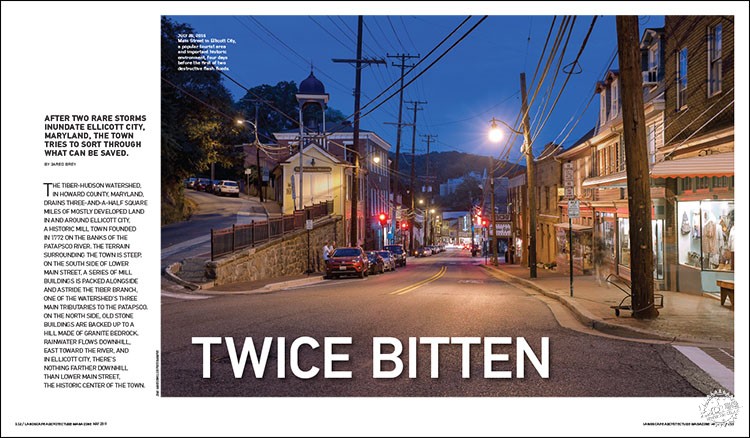
两场罕见的暴雨袭击了美国马里兰的埃利科特市,政府相关人员不得不开始思考哪些东西值得保留/After two rare storms inundate Ellicott City, Maryland, the town tries to sort through what can be saved.
TWICE BITTEN BY JARED BREY
由专筑网胡婧宜,李韧编译
台伯河-哈德逊河流域位于马里兰州霍华德县,接纳埃利科特市及其周围地区的排水。埃利科特市是一座历史悠久的磨坊镇,建于1772年,位于帕塔普斯科河畔。镇周围地形陡峭。在主要街道的南侧,一系列磨坊建筑物沿台伯河分布或横跨河流,这是帕塔普斯科河的三条主要支流之一。在北侧,古老的石头建筑物背靠着由花岗岩基岩构成的山丘。雨水沿着山坡向下流动,向东汇入河流。在埃利科特城,城镇中心南主街的地势最低。
当我在2月初来到这里时,天气已经变得好一些,我向山下走到南主街,街道较窄,气温较低,光线变暗。在我右侧一排木板店面后面,我可以听到台伯支流的水流声。空气中仍然弥漫着地下室的阴湿味道。
2016年7月30日晚上,一场暴风雨袭击了埃利科特城,在三小时内给台伯河、哈德逊河流域带来了6.5英寸的降雨。河水漫过了哈德逊支流的河岸,淹没了主街几乎所有的建筑和近200辆车,据报道,一些车被冲入了帕塔普斯科河。台伯河哈德逊河和纽科特河的汇流将流入帕塔普斯科河。它强有力的潮水冲击了南主街,甚至冲毁了一些建筑的墙体。在一个居民发布的YouTube视频中,一股激流混杂在顺主街而下的平稳水流中,击碎了凯普兰百货公司的橱窗。洪水破坏了主街几乎所有的建筑,最大水深超过6英尺。用餐人群被困在南主街的二层餐厅,北主街的Tersiguel法国餐厅损失了大量地下室的藏酒,有两人在这场洪水中丧生。
经过了这场千年一遇的洪水,霍华德县政府及埃利科市城居民决定要把城市修复得比从前更加牢固。他们以“修建模范弹性社区”为目标,制定了规划策略,旨在重建、保护城市环境,保护城镇古迹,并实现经济振兴。他们开始整理从洪水干预措施到城市形象重塑的一系列措施。据官方报道,一年过后,90%的商业活动得以复原。
The Tiber-Hudson watershed, in Howard County, Maryland, drains three-and-a-half square miles of mostly developed land in and around Ellicott City, a historic mill town founded in 1772 on the banks of the Patapsco River. The terrain surrounding the town is steep. On the south side of lower Main Street, a series of mill buildings is packed alongside and astride the Tiber Branch, one of the watershed’s three main tributaries to the Patapsco. On the north side, old stone buildings are backed up to a hill made of granite bedrock. Rainwater flows downhill, east toward the river, and in Ellicott City, there’s nothing farther downhill than lower Main Street, the historic center of the town.
When I visited at the beginning of February, the sun was out and it was warm enough to leave my jacket in the car. Walking downhill into lower Main, where the street is narrower, the air temperature dropped and the shadows darkened. On my right, behind a row of boarded-up storefronts, I could hear the Tiber Branch rushing along parallel to Main Street. It smelled like a basement.
On the night of July 30, 2016, a storm rolled in and sat directly on top of Ellicott City, dropping 6.5 inches of rain in the watershed in just three hours. Water jumped the banks of the Hudson Branch uphill and flowed down Main Street, flooding most of the buildings and sweeping around 200 cars downstream, with some ending up in the Patapsco River, according to reports in the Baltimore Sun. The Tiber Branch, which captures both the Hudson and the New Cut Branches before dumping into the Patapsco, hit its peak velocity toward lower Main, strong enough to break through the back side of some of the buildings. In one video posted by a resident on YouTube, amid the steady flow of water rolling down Main Street, a powerful rush of water shoots out the front windows of Caplan’s Department Store. The water damaged buildings all along Main Street and reached a maximum depth of more than six feet toward the east end. Diners were trapped on the second floor of restaurants on lower Main, and Tersiguel’s French Country Restaurant, on upper Main, lost much of its wine cellar and equipment in the basement. Two people were killed.
In the aftermath of the flood, which was later categorized as a 1,000-year flood—a marginally useful term referring to a flood with a 0.1 percent chance of occurring in any given year—Howard County officials and Ellicott City residents and businesses vowed to bounce back stronger than before. They launched a master planning effort aimed at becoming a “model, resilient community” with the core goals of rebuilding, protecting the environment, preserving the town’s heritage, and revitalizing the economy. And they began sorting through everything from flood-mitigation interventions to rebranding campaigns. By the time a year passed, officials reported, 90 percent of businesses had returned to Main Street.

埃利科特市兴建于1772年,是马里兰州主街系统的一部分/Ellicott City, founded in 1772, is part of the Main Street Maryland network. Photo by tkarpati/Shutterstock.com.
去年五月,距离一项长期规划公布仅几周前,暴雨又一次袭击了这座城市。在一个周日的下午,几乎等量的降雨在三小时内倾倒在城市里,这次的降雨形成了两次洪峰。哈德逊河和台伯河均漫过了河岸,苦心重建的建筑再一次被摧毁。Tersiguel餐厅的店主Angela Tersiguel在两年内第二次遣散了员工。一名国民卫队队员Eddison Hermond,在尝试帮助一位居民救援她的猫的时候被水冲走,两天后他的尸体在帕塔普斯科河里被发现。
在第二次洪水过后,县长Allan Kittleman组建了一支顾问团队重新修订总体规划。这支团队由巴尔的摩景观设计事务所Mahan Rykiel带领。这次他们要将生命安全作为首则,制定一项五年洪水干预措施。在接下来的数月中,县政府将重心放在洪水问题上,基于规划采取了一系列疏通河流的措施。其中最重要的一项是在主街南端建立河岸公园。公园由一系列亲水平台以及一个露天舞台组成。为了修建这座公园,县政府拆除了南主街的10座建筑,它们都是埃利科特市的古老建筑。Kittleman于十月底正式公布了这项计划,数周后他就输掉了县长竞选。那时对于古迹保护组织和多数县居民来说,这项计划与其说是保护埃利科特市,不如说是在破坏它。
当我遇到Mahan Rykiel的ASLA事务所的主席Tom McGilloway的时候,他正和事务所研究主任Isaac Hametz以及商务交流发展主任Bryzn Dunn一起站在停车场的砖石小广场上。这个停车场位于北主街,离Tersiguel餐厅不远。在停车场的尽头,哈德逊河的源头从La Palapa烧烤餐厅下方的河道中涌出,蜿蜒向东消失在人行道下方,在广场的另一端再次出现,并在那里汇入台伯河。这部分的河道过于狭窄无法容纳洪峰水量,导致了涌向南主街的洪水,并引发了两次洪水中最严重的破坏。
“这就是所有问题的根源。”McGilloway说。
洪水发生一年后,一位规划官员在一场公众会议上这样说:“规划的目标是让埃利科特市尽快恢复正常。”为实现这个目标需要清理并修复城市,如重建挡土墙及其他基础设施。Mahan Rykiel设计事务所负责制定相关的长期规划。
“洪水只是问题的一个方面,解决洪水问题同时也可以促进诸如振兴经济、增加公共空间、增加停车空间、注入发展机遇等机遇。”McGilloway这样认为,“在2018年洪水前,我们设想着用一些理想的干预措施解决洪水问题,可以将河流保留,并使其稳定。这项措施无法挽救南主街,但不会让它变得更糟。”
Then, last May, just weeks before a draft of the long-range master plan was set to be made public, it happened again. Another storm dropped nearly the exact same amount of rain in three hours on a Sunday afternoon, this time with the heaviest rain falling in two waves. The Hudson and Tiber Branches jumped their banks. Painstakingly renovated buildings were destroyed anew. Angela Tersiguel, a co-owner of Tersiguel’s, laid off her entire staff for the second time in two years. Eddison Hermond, a National Guardsman, was swept away by the rushing waters as he tried to help a resident who was rescuing her cat, and officials found his body on the banks of the Patapsco two days later, according to news reports.
After the second flood, then-County Executive Allan Kittleman directed the team of consultants working on the master plan, led by the Baltimore-based landscape architecture firm Mahan Rykiel, to develop a five-year flood-mitigation action plan, prioritizing life safety above the four previously outlined planning goals. Over the next few months, prior to the county executive’s election in November, the county’s plan crystallized into a series of moves meant to aid stream conveyance throughout the watershed. The signature move was the creation of a river park at the bottom of Main Street, with terraced steps and a stage for performances. To create the park, the county would have to acquire and demolish 10 buildings on lower Main—10 of the oldest buildings in Ellicott City. Kittleman, a Republican, formally introduced the plan at the end of October, just a few weeks before losing his re-election campaign. By that point, to preservationist groups and many residents of the town, the plan to save Ellicott City looked a lot like a plan to destroy it.
When I met Tom McGilloway, ASLA, a principal at Mahan Rykiel, he was standing in a small brick plaza in parking lot D with Isaac Hametz, ASLA, the firm’s research director, and Bryan Dunn, the director of communications and business development. Parking lot D is on upper Main Street, close to Tersiguel’s. On the far side of the parking lot, the south-flowing Hudson Branch briefly springs out from a channel beneath La Palapa Grill & Cantina, bends to the east, then ducks under the pavement before appearing again on the other side of the plaza, where it joins with the Tiber. Because the streams in that part of the town are stuffed into channels that are too narrow for their peak flow, they gained more velocity as they flowed toward lower Main, where the worst destruction occurred.
“This is the point where everything comes together,” McGilloway said.
After the 2016 flood, as one planning official said at a public meeting the following year, “The goal was to bring Ellicott City back to a state of normalcy as soon as possible.” That goal required immediate cleanup and restoration work, such as repairing and stabilizing retaining walls and other infrastructure. But Mahan Rykiel was hired to coordinate a master plan that took a longer view.
“The flooding was just one aspect of it, but addressing the flooding provided an opportunity to almost hit restart on the economy, to deal with some things like the lack of public space, to deal with parking, to deal with opportunities for infill development,” McGilloway said. “Before the 2018 flood, we were talking about some pretty significant interventions up here that demonstrated that we could take the flooding off of this part of Main Street, if we keep the water here and address this. It didn’t solve lower Main, but it didn’t make lower Main worse.”
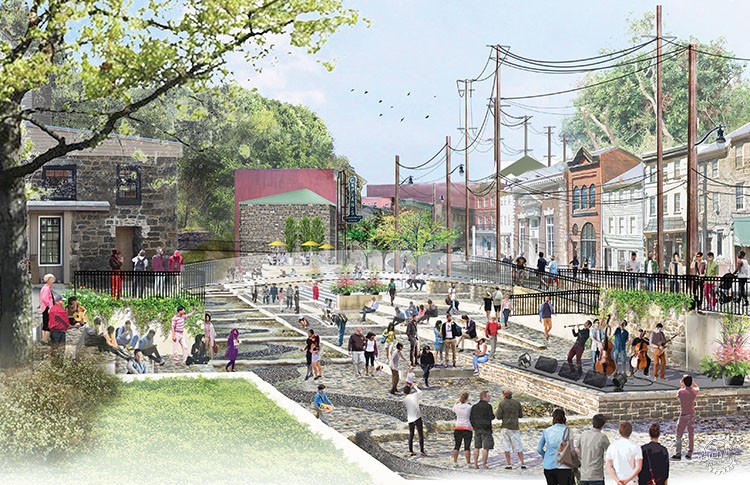
霍华德新镇长Calvin Ball暂停了这项备受争议的方案,即拆除南主街10座历史建筑。前镇长计划用一座河岸公园取代这些建筑以保护洪泛区/Howard County Executive Calvin Ball has hit pause on a controversial plan to demolish 10 historic buildings on lower Main. The previous county executive endorsed a proposal that would have replaced them with a river park and restored some of the floodplain. Image courtesy Mahan Rykiel.
2018年春天,在第二次洪水之前,规划团队计划部分移除停车场尽头两座建筑,让哈德逊河在洪水期通过。他们准备用立体停车的方式取代平面停车,并在沿途设置滨河设施。这些规划措施的目的在于拓宽河道,减缓哈德逊河流速。
在整个规划过程中,许多埃利科特市居民都强烈地感觉到,最近在主街上方山区的城市郊区建设,是造成洪水的原因,或者至少增加了它的破坏性。而且这些建设确实会降低土地的渗透能力,并恶化洪水灾情。但根据霍华德县聘请的工程公司McCormick Taylor进行的水文和水力学研究,城郊开发并不是造成洪水的主要因素。如果除了主街以外的流域内的一切都恢复到“森林覆盖状况良好”的情况,百年一遇的洪灾依然只能降低不到30%。该公司由此得出结论,南主街仍然位于洪泛区的中心,它仍然可能会被浸没在洪水之中。
“如果你仅开发了主街,但是洪泛区的其它地区都有植被覆盖,可能洪水的程度会有所减轻,但仍然不可避免,因为这片地区的主要土质都是花岗岩。”McGilloway说,“因为水流速过快,即使地表都由植被覆盖,水量会下降,但依然无法被完全吸收。它就像一块海绵,你慢慢地在海绵上倒水,它会不断地吸收。你倒的速度很快,它就会滴落下来,在这里是一样的。所以我们显然会受到限制。我想,你可以摧毁整个城镇,做一个弹性边缘更广泛的洪泛区,但......”
他没有完成这个想法,因为摧毁城镇显然不可能。我们向下坡的南主街走去。
By the spring of 2018, before the second flood, the team had developed a plan for upper Main that involved removing parts of two buildings on the west end of parking lot D to create a wider, open channel for the Hudson to flow through, replacing the lot spaces with structured parking, and building streamside amenities along the way. The idea behind all the interventions was to give rushing water a chance to spread out and slow down as it moves toward the Patapsco.
Throughout the planning process, many Ellicott City residents maintained a strong sense that recent development in the hills above Main Street, where the pattern is suburban, is what caused the flooding, or at least what made it so destructive. And it’s true that those developments reduce the absorptive capacity of the land and make flooding worse. But according to the hydrology and hydraulic studies carried out by McCormick Taylor, the engineering firm hired by Howard County, development is not the primary factor. If everything in the watershed except for Main Street were restored to “woods in good condition”—the full absorptive capacity of forested land prior to any development—discharge flows would be reduced less than 30 percent during 100-year storm events, the firm concluded. Lower Main would still be in the center of the floodplain, and it would still be under four to six feet of water.
“If you just had Main Street developed but everything else in the watershed was woods in good condition, you wouldn’t have the same level, but you’d still have significant flooding, because this is all granite,” McGilloway said. “The intensity of the water that comes down, even if [the land] is vegetated, most of it rolls off. It’s like a sponge. You pour water slowly on a sponge, it absorbs it. You pour it really fast, it rolls off. You have the same thing here, so we’re obviously constrained. You could, I imagine, wipe out the whole town and do a broader floodplain with soft edges, but…”
He didn’t finish the thought, because wiping out the town is explicitly not the point. We walked downhill toward lower Main.

Caplan杂货店在2018年5月的洪水中被完全摧毁/Caplan’s Department Store was all but destroyed after a flood in May of 2018. Photo courtesy Howard County Department of Planning and Zoning.
埃利科特市中心的人行道狭窄,在这两次洪水期间,所有的砖铺都被掀离了地面并冲入河中。镇上最古老的建筑物坐落在主街的南端,埃利科特市火车站是B&O铁路沿途的一个站点,也是美国现存最古老的旅客列车站。正如霍华德县公共工程部主任Jim Irvin告诉我的那样:“最严重的问题就在于受灾区域在最重要的地方。”
自从2018年的洪水之后,规划工作的重点转移到生命安全上时,主街南端的10座建筑物的业主向该县寻求收购。与镇上的其他人一样,业主们一直渴望在2016年洪水之后让城市恢复生机,但在2018年的洪水之后,根据前县官员的说法,他们不相信他们能够再次这样做。2016年之后,许多埃利科特市居民感觉他们经历了一场千载难逢的浩劫。在2018年之后,有一种感觉,它可能会在任何时候重复发生。当它发生时,位于主街南端的建筑会一次又一次地受到破坏,因此不知道能够存留多久。因此,该县开始了收购建筑物的谈判,Mahan Rykiel负责设计一个可能取代这些建筑的概念方案。
McGilloway手里拿着一台笔记本电脑,打开了规划文件。当我们走向主街南端时,我们不得不在台伯河的湍流声中提高音量交谈。他向我展示了最新版的规划方案,项目将从2018年10月开始,特点在于阶梯状滨河公园取代了南主街南端历史悠久的磨坊建筑。
“失去这组历史建筑物真是太可怕了,但这可能会让埃利科特市更强大。”McGilloway说,“我是古迹保护主义者,我的很多工作都是保护古迹,但我不准备因此而忽略死亡。洪水可能毁掉埃利科特市。我认为这项规划将使它成为一个与以往完全不同的城市,它同时也可能让城市成为一个能够回应自然变化的新历史。”
建筑师Rob Brennan也是马里兰州古迹保护霍华德县分部主任,住在Catonsville附近,他也在埃利科特市市中心帕特普斯科河对面的一座改建教堂里进行他的实践。直到2016年,他一直在北主街工作。
The sidewalks in downtown Ellicott City are narrow, and during the last two floods, all the brick paving was torn out of the ground and washed into the river. The oldest buildings in the town sit at the bottom of Main Street, as does Ellicott City Station, a stop on the B&O Railroad, and one of the oldest surviving passenger train stations in the United States. As Jim Irvin, the director of the Howard County Department of Public Works, told me, “The most important thing in town is in the worst spot in the watershed.”
After the 2018 flood, when the focus of the planning effort shifted to life safety, the owners of 10 of the buildings at the bottom of Main Street approached the county about acquiring them. Like the rest of the town, the owners had been eager to bring their buildings back to life after the 2016 flood, but after the 2018 flood, according to former county officials, they weren’t convinced they could do it again. After 2016, many Ellicott City residents had a sense that they had lived through a once-in-a-lifetime event. After 2018, there was a sense that it was likely to happen over and over again, at any time. When it did, the buildings on lower Main would be in for repeated beatings, with no telling how long they would stay standing. So the county began negotiations to acquire the buildings, and Mahan Rykiel was put to the task of designing a concept for what might take their place.
McGilloway was carrying a small laptop in his hand with a PDF of the master plan open on the screen. As we walked toward lower Main, we had to raise our voices over the rush of the Tiber. He showed me the last iteration of the plan, from October 2018, which featured the terraced river park in place of the historic mill buildings on the south side of lower Main Street.
“It’s horrible to lose this group of historic buildings, but that could potentially make Ellicott City stronger,” McGilloway said. “I’m a preservationist—a lot of my work is preservation. But I wasn’t ready to die on the sword saying ‘This is going to ruin Ellicott City.’ I think it would make it a different Ellicott City, but I think it would have been part of Ellicott City’s evolving history, and responding to nature.”
Rob Brennan, an architect and the Howard County director for Preservation Maryland, lives in nearby Catonsville but keeps his practice in a converted church building high on a hill across the Patapsco River from downtown Ellicott City. Until 2016, he had an office on upper Main Street.
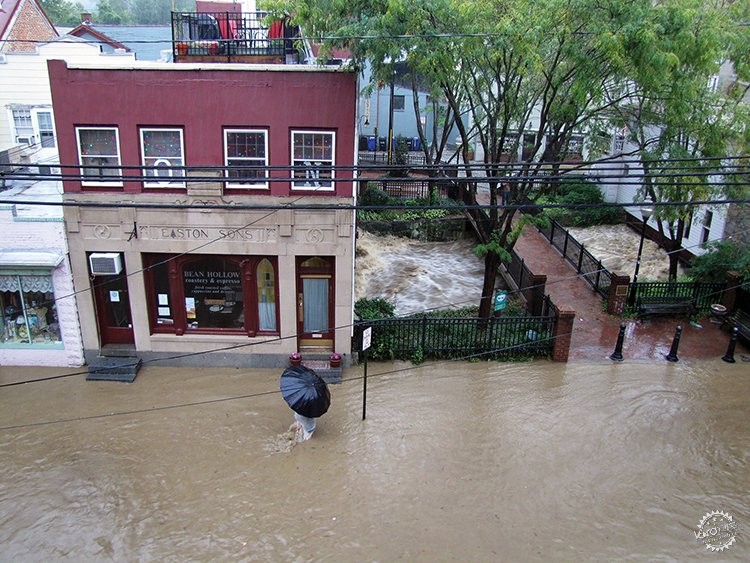
埃利科特市经常发洪水。2011年的一场洪水破坏了主街的商业活动/Ellicott City has always flooded. A flash flood in 2011 damaged businesses along Main Street. Photo by John L. Beck.
“我们建筑的地下室十分潮湿。”Brennan告诉我,“这是古老的石头基础,泥土地板,紧邻台伯河,这里甚至有点霉味。你知道,在埃利科特城总是有这种困扰。我们都知道这是一个潮湿的地方,你会看到下雨时河流水位变高。”
在2016年洪水之后,Brennan将他的实践活动移到了地势更高的位置,但作为由前县长Allan Kittleman任命的总体规划社区咨询小组的成员,他一直致力于重建工作。该小组对于规划方案讨论了一年,在此期间,当地的大部分建设工作都在试图加固现有的基础设施。在2018年春天,社区咨询小组帮助完成总体规划草案的最后润色,与顾问讨论营销和图形等细节。一张宣传图片展示了一名穿跑鞋的男子走上一组石阶,上面写着“很明显他在埃利科特市老城区购物”。
“然后洪水又来了。”Brennan说,“它抹去了我们的一切努力。我们的态度完全改变了,变得更加关注生命安全。它迫使城市改造变快。他们想出了拆迁计划,我们不打算重建。人们不想搬回来,所以我们会想把建筑拆除,建造一个大蓄水池。”
Brennan也是是埃利科特市委员会的成员。埃利科特市委员会是一家非盈利业务开发集团,隶属于马里兰州主街保护体系。但是当委员会支持霍华德县拆除大街上的10座建筑物的计划时,Brennan辞职了。埃利科特市主街是一个国家级历史遗迹,包括200多座建筑和埃利科特火车站,这是一个国家历史地标。由于该县正在寻求联邦拨款,拆除部分地区的计划违反了1966年“国家历史保护法案”第106条,该法案要求联邦机构考虑可能受其工作影响的地区的历史价值。 “建筑群的结构本身具有价值。”马里兰古迹保护组织的执行董事Nicholas Redding说,“事实上,当我们讨论南主街建筑群体时,我们应该考虑它们在整个地区的价值。因此,如果我们拆除了其中的大部分建筑,我们会失去该空间的完整性、真实性和整体空间。”
在2018年夏季,随着该县的重点从长期规划转向立即减灾,总体规划被削减为一系列可在五年内实施的项目,其目标是改善溪流运输,在9月的一次公开会议上,Mahan Rykiel展示了该计划中哈德逊河岸部分的草图,即北主街停车场被开放覆盖植被的通道横穿而过。
“The basement of our building had always been damp and wet,” Brennan told me. “It was an old stone foundation, dirt floor, right adjacent to the old Tiber Creek, which had been undergrounded at that point, so it was kind of a musty smell. In Ellicott City, there’s always been that connection to the earth, you know. We all knew it was a wet place, and you’d see the creeks would run high when it rained.”
After the 2016 flood, Brennan moved his practice to higher ground, but committed himself to the rebuilding effort as a member of the master plan community advisory group appointed by former County Executive Allan Kittleman. The group met for a year, during which most of the actual work that was happening on the ground was stabilizing existing infrastructure. In the spring of 2018, the community advisory group was helping to put the finishing touches on a draft of the master plan, talking with the consultants about details like marketing and graphics. One promotional image shows a man’s muscular calves in running shoes walking up a set of stone steps, with the phrase, “It’s obvious he shops in Old Ellicott City.”
“And then the flood happened,” Brennan said. “That just wiped everything out. Complete change of attitude. It became more about life safety…. It forced them to move into quicker-action mode, and they came up with the demolition plan, and that we’re not going to rebuild. People didn’t want to move back in, so we’ll buy your buildings, we’ll tear them down, we’ll create a big stormwater pond.”
Brennan had also been a member of the Ellicott City Partnership, a nonprofit business development group that is part of the Main Street Maryland network. But when the partnership sided with Howard County on the plan to tear down the 10 buildings on lower Main Street, Brennan resigned.
Main Street in Ellicott City is a National Historic District, encompassing more than 200 contributing buildings and Ellicott City Station, a National Historic Landmark. Because the county was seeking federal grants, the plan to demolish part of the district triggered Section 106 of the National Historic Preservation Act of 1966, which requires federal agencies to consider the historic value of areas that might be affected by their work.
“The structures themselves are of value individually,” said Nicholas Redding, the executive director of Preservation Maryland. “But really, when you’re talking about lower Main collectively, there’s value in the totality of it—in the district that they create. So by removing a big chunk of them, you lose the integrity and authenticity and feeling of that space.”
During the summer of 2018, as the county’s focus shifted from long-range planning to immediate flood mitigation, the master plan was pared down to a set of projects that could be implemented in five years, with the goal of improving stream conveyance as much as possible. At a public meeting in September, Mahan Rykiel presented sketches of the “Hudson Bend” portion of the plan—the open, vegetated channel through lot D on upper Main Street.
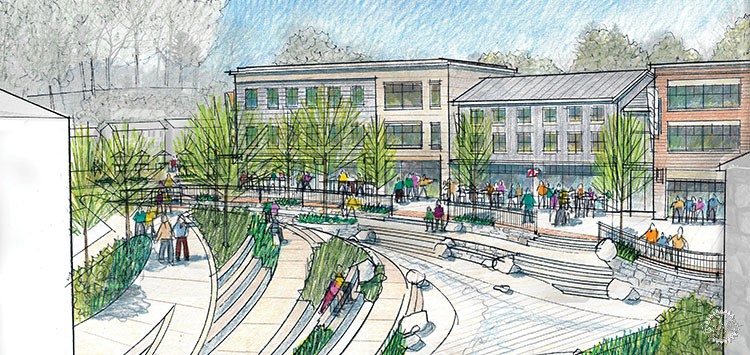
哈德逊河岸部分的规划旨在发展洪水对于公共空间的机遇/The Hudson Bend portion of the plan was meant to provide development opportunities as well as flood mitigation and new public space. Image courtesy Mahan Rykiel.
10月初,Baltimore Sun报道,县议会批准了一项法案,为收购和拆除19座建筑物提供资金,其中包括位于下游的10座历史建筑。但投票结果并不一致。Calvin Ball作为一名县议员和民主党人,他在县长的竞选中向Kittleman提出挑战,他是投票反对该计划的两名理事会成员之一。Ball告诉我,他反对这个五年计划,因为他认为这个计划太匆促,整个计划过程应该更加透明,而且因为项目的资金没有通过正常的预算检验程序。
Ball最终赢得了县长的选举。虽然拆迁计划已成为埃利科特市的有分歧的问题,但很难知道它在县选举中扮演了什么角色。历史性埃利科特城市公司总裁Joan Becker告诉我,去年霍华德县的一位共和党人不可能当选。Brennan认为拆迁计划是选举结果的决定性因素。
自上任以来,Ball推出了一项名为“平安埃利科特市”的计划,该计划的重点是公共安全和维持河流流量。该县正在继续与建筑业主谈判,目的是收购下主要建筑物,但Ball至少暂时停止了拆除它们的想法,称该县应该尽一切努力保护埃利科特城的历史特色。他回应了五年计划的许多反对者所提出的观点,即使将这10座建筑物拆除以便将洪泛平原归还给河流,2016年和2018年的风暴仍将淹没南主街。
Ball说:“前一个计划在主街上留下了四到六英尺的洪水,导致5000万美元经济损失。而且它会拆除南主街的至少10座建筑物。坦率地说,如果人们害怕洪水,我不确定在主街南部设立步道是不是一个可行的想法。”
Ball还将总体规划过程搁置。截至2月份,他还没有准备好再说它何时重新开始。 根据国家气候评估报告,全国各地的暴雨正在变得越来越频繁,其中东北部,中西部和大平原上游地区的降雨量增幅最大。预计气候变化将加速这一趋势,并使许多地区的洪水更加激烈。根据国家气象局的数据,埃利科特市本身特别容易受灾,是Baltimore和华盛顿周边44个县最容易受到洪水泛滥的地方。2016年和2018年的暴雨都被归为千年一遇,在某一年内发生的概率仅为0.1%。但随着气候变化,这种归类变得不再那么科学了。2016年的风暴在7点到10点之间的3小时内在埃利科特市倾倒了近800英亩每英尺的水。为了说明保持这一水量所需的储存容量,McCormick Taylor水资源总监Crist Brooks在去年9月的一次公开会议上告诉与会者,他们设想了在停车场上建立一座80层的塔楼,一个北主街上占地约一英亩的建筑,这座塔楼周围的建筑都要高一些。McCormick Taylor推荐的所有干预措施都是为了最大限度地保留上游和通过河道输送的水量。 一些居民支持在主街两侧挖掘隧道的建议,这意味着在洪水期间容纳哈德逊河和台伯河的溢流并将水输送到帕塔普斯科河。位于主街北方旧哥伦比亚公园的一个前院的一个临时广告牌上写着“不要拆迁!要隧道!”根据McCormick Taylor的建模,该解决方案可以保留大街上的大部分水。但它带来了巨大的工程挑战,需要五年多的时间才能完成,如果它在风暴事件中被堵塞或以其他方式失败,仍然可能使城镇处于危险之中。
At the beginning of October, the Baltimore Sun reported that the County Council approved a bill to fund the acquisition and demolition of 19 buildings, including the 10 historic buildings on lower Main. But the vote wasn’t unanimous. Calvin Ball, a county councilman and a Democrat who was challenging Kittleman in the county executive’s race, was one of two council members to vote against the plan. Ball told me he had opposed the five-year plan because he thought it was rushed, that the process should have been more transparent, and because the funding for the projects wasn’t allocated in the typical budget process.
Ball went on to win the county executive’s election, and while the demolition plan had become a divisive issue in Ellicott City, it’s hard to know what role it played in the county election. (I heard a range of theories. Joan Becker, the president of Historic Ellicott City Inc., told me a Republican couldn’t have been elected dogcatcher in Howard County last year. Brennan suggested the demolition plan was the decisive factor in the outcome.)
Since taking office, Ball has launched a plan called Ellicott City Safe and Sound, which is focused on public safety and maintaining stream flows. The county is continuing to negotiate with building owners to acquire the buildings on lower Main, but Ball has at least temporarily put a stop to the idea of demolishing them, saying the county should do everything it can to protect the historic character of Ellicott City. He echoes a point made by many opponents of the five-year plan: Even with those 10 buildings removed to return some idea of a floodplain to the watershed, storms like those in 2016 and 2018 would still flood lower Main.
“The former plan left four to six feet of floodwater on Main Street and was $50 million,” Ball said. “And it would tear down at least 10 buildings on lower Main to have this riverwalk, which, frankly, if people are afraid of flooding, I’m not sure a riverwalk at the bottom of Main Street was going to be the best answer.”
Ball has also put the master planning process on hold, and as of February, he wasn’t ready to say when it might start again.
Around the country, heavy downpours are becoming heavier and more frequent, according to the National Climate Assessment, with the greatest increase occurring in the Northeast, the Midwest, and the Upper Great Plains. Climate change is expected to accelerate that trend and to make flooding more intense in many regions. Ellicott City itself is particularly ill-placed, the most vulnerable location for flash flooding in the 44 counties around Baltimore and Washington, according to the National Weather Service. Both the 2016 and 2018 storms are categorized as 1,000-year events, with just a 0.1 percent chance of occurring in a given year. But as the climate changes, those categories become less useful.
The 2016 storm dumped nearly 800 acre-feet of water on Ellicott City in the three hours between 7:00 and 10:00 p.m. To illustrate the storage capacity needed to hold that volume of water, Chris Brooks, the director of water resources for McCormick Taylor, told attendees at a public meeting last September to picture an 80-story tower planted on parking lot F, a roughly one-acre lot on upper Main. It would be substantially taller than any building in Baltimore, 12 miles east. All of the interventions recommended by McCormick Taylor were meant to maximize the amount of water retained upstream and conveyed through the stream channels.
Some residents have come out in support of a proposal to dig two giant tunnel bores on either side of Main Street, meant to capture overflow from the Hudson and Tiber Branches during floods and convey the water underground to the Patapsco. (A makeshift billboard in one front yard on Old Columbia Pike above Main Street says “Demolition No! Tunnel Yes!”) That solution would keep most of the water off Main Street, according to modeling done by McCormick Taylor. But it presents enormous engineering challenges, would take more than five years to complete, and could still leave the town at risk if it were to become clogged or otherwise fail during storm events.
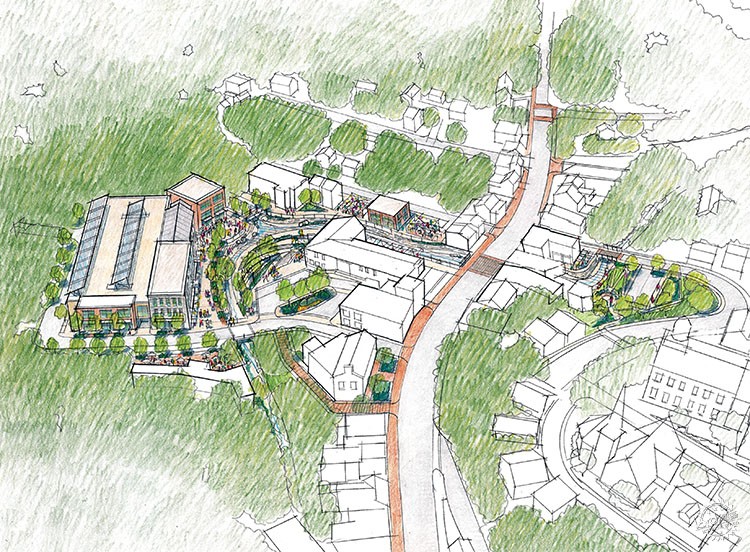
设计方案包括拆除两栋建筑以拓宽河道/One proposal included partially demolishing two buildings to widen the channel and add streamside amenities. Image courtesy Mahan Rykiel.
“埃利科特城在两年内发生了两次千年一遇的暴雨。”Isaac Hametz站在主街南端说道,“就统计而言,这简直是疯了。它在统计上没有意义。但我认为这正是我们在美国会越来越多地看到的现象,我认为问题就变成了,我们如何处理这样可爱又古怪的地方,这些可能完全没有政治或经济重要意义的地方,一个完全不像曼哈顿下城、洛杉矶、旧金山、加尔维斯顿或华盛顿特区的地方?”
2016年洪水过后,Tersiguel餐厅所有人Angela Tersiguel被诊断患有创伤后应激障碍,并在治疗中度过了10个月。但在那段时间里,她说,埃利科特市民有一种明显的兴奋。人们觉得他们“击败了人们通常无法击败的东西。”Tersiguel在总体规划社区咨询小组服务,最近,她被任命为县行政委任的委员会成员,以探索创建社区镇的发展模式。她说她现在认为参与城市规划是她工作的一部分,但为了重新开展业务,她也无法完全投入这项工作。
“我太累了。”她告诉我,“我真的没有精力了。我想有时会发生什么,或者会发生什么,当第三次洪水来临时,我知道我没有精力去管它。”
保护主义者想知道拆除埃利科特市最古老的建筑群的好处,而不是只减少几英尺的洪水泛滥。在一次公开会议上,一位居民问规划小组他们能否减少埃利科特市80-90%的洪水?县政府回避了这个问题,但它反映了规划一个位于洪泛区中心的城镇的挑战,即每个项目的目标,包括下游的拆迁建议,洪水最大减少的程度。 Tersiguel说,拆迁将是该镇的重大损失。但她说,这些方式会让我们接受道德的挑战。”
“对我而言,我只需要有人成为一名领导者,并能够真正做出艰难的决定。” Tersiguel说。
“这就是生活。我们做出决定。我们有时不知道它们的最佳结果。我们仍然需要去尝试。”
编者按:此文发布后,霍华德县长Calvin Ball召开会议宣布他的平安埃利科特市计划的第二阶段,为历史悠久的城镇提供了一系列减灾措施。正如城市实验室所总结的那样,耗费从6350万美元到1.75亿美元不等。 5月初,Ball宣布该县选择了一项涉及拆除四座建筑物的计划,且不同于之前的计划,该县准备建造一条隧道将地下水输送到帕塔普斯科河。
“Ellicott City had two one-in-1,000-years storm events in a two-year period,” said Isaac Hametz, standing at the bottom of Main Street. “That is, statistically, bonkers. It doesn’t make sense statistically. But I think it is exactly what we’re going to see more and more of in the U.S., and I think the question becomes, how do we deal with places like this that are cute and quaint but don’t have the political or economic resources to do any of the heroic things that we talk about in places like Lower Manhattan or Los Angeles or San Francisco or Galveston or Washington, D.C.?”
After the 2016 flood, Angela Tersiguel, the co-owner of Tersiguel’s restaurant, was diagnosed with post-traumatic stress disorder and spent 10 months in therapy. But during that period, she said, there was palpable excitement in Ellicott City. People felt like they had “beat this thing that people don’t normally beat.” Tersiguel served on the master plan community advisory group, and more recently, she was appointed to serve on a committee appointed by County Executive Ball to explore creating a community development corporation for the town. She said she now sees participating in town planning as part of her job, but alongside restarting her business, the work takes a toll.
“I’m tapped out,” she told me. “I literally have no energy left. I think sometimes about what would happen, or what will happen, when the third flood comes, and I know I don’t have the energy for it.”
Preservationists and others wonder about the benefit of ripping out a substantial portion of Ellicott City’s oldest built fabric if doing so would only reduce peak flooding by a few feet. At one public meeting, a resident asked the planning team what their target was for reducing flooding in Ellicott City—80 percent? Ninety? As a response to the question, the county’s answer seemed evasive, but it reflected the challenges of planning for a town that sits in the center of a floodplain: The target for every project, including the demolition proposal on lower Main, is maximizing the flood reduction to the extent that’s possible. Tersiguel says that demolition would be a major loss to the town. But trying to keep the buildings intact, possibly even occupied, she said, is “putting us over the ethical line.”
“For me, I just need somebody to be a leader and say, ‘Some really, really hard decisions are coming down the pike, but I’m the person that’s going to make them,’” Tersiguel said.
“That’s life. We make decisions. We sometimes don’t know the best long-term outcome of them. We’ve still got to make them.”
Editor’s Note: After this story went to press, Howard County Executive Calvin Ball held a meeting to announce the second phase of his Ellicott City Safe and Sound plan, laying out a range of options for flood mitigation in the historic town. As CityLab covered, the options came with price tags ranging from $63.5 million to $175 million. In early May, Ball announced that the county had selected a plan that involves demolishing four buildings and, unlike the previous plan, constructing a tunnel to carry water underground to the Patapsco River. Read more about the new plan here.
|
|
